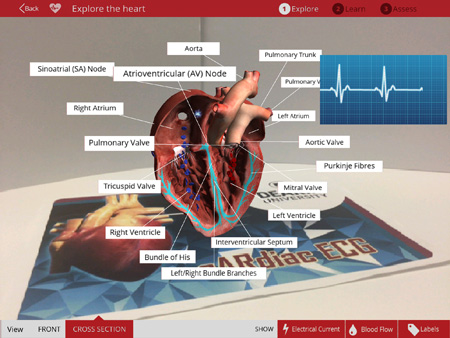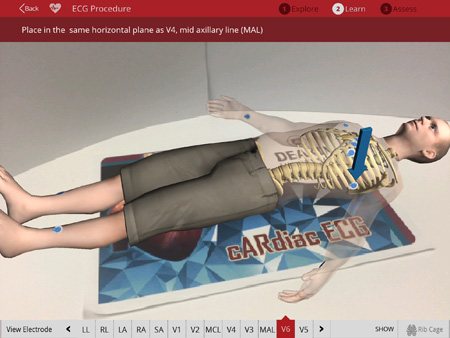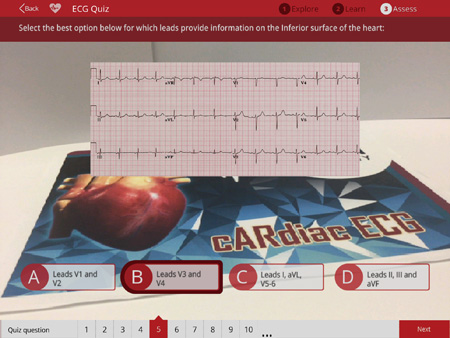By Colin Warren, Senior Lecturer, Medical Education (eLearning) at the School of Medicine, Deakin University.
The aim of the cARdiac ECG augmented reality (AR) application was to create a realistic, three-dimensional, technology-enhanced learning environment where students can conceptualise both the underlying physiology of the normal beating heart, and understand the pathology leading to critical heart events. We wanted to use the AR technology to assist students make the cognitive leap linking previously taught two-dimensional textbook content with real world situations via a 3D model.
The cARdiac ECG app has the capacity to enhance teaching and learning in both small and large class sizes, i.e. allowing individuals the opportunity to learn and revise prior to entering small group classes (simulation, tutorial) and large group (lecture) settings. Individuals that need further revision, based on assessment results within the app itself, or as a result of real patient learning encounters such as during clinical placement, can revisit the learning experience anytime, anywhere in a fashion tailored to their specific needs.

Using the cARdiac ECG app students can see what is happening inside the heart where the animated scenarios display animation and traces in real time with overlays and labels. In this way, the AR platform creates authentic learning opportunities through an engaging interactive model. A mobile device app was selected to trigger the AR experience because this facilitates portable, just-in-time learning that students can access in clinical settings and places outside the university classroom. This is recognised in the 2017 Horizon report where it is acknowledged that using mobile devices for learning, “leverages this technology to make learning portable, meaning a learner can have access to materials virtually anywhere” and “continues to gain traction in education because it is particularly useful for learning as it enables people to learn and experience new concepts wherever they are, often across multiple devices” (Adams Becker, et al., p40).
Feedback from students indicates that they greatly value being able to interact with the virtual heart model and visualise this in 3D. These features were instrumental in students having an enhanced and engaging learning experience. Student comments on their use of the cARdiac ECG app included; “It was good because it allowed us to rotate the heart and see it as a moving 3D model” and “Seeing different + changing regions of the heart that are only appreciated in 3D” and “More immersive than a textbook. Would be good support to be able to use at home for revision” and “Showing the actual heart with corresponding ECGs – It is engaging.” To evaluate the app, a reference group of medical students were asked to rate whether they felt confident in applying and understanding ECGs on a scale of 1 (strongly disagree) to 5 (strongly agree). The average score prior to using cARdiac ECG was 2.45, and after using cARdiac ECG this score increased to an average of 4.18, which represents a highly significant increase in student confidence (p=0.001 on paired T testing). We believe these results reflect the positive impact created by the app, which has led to high levels of student engagement and discussion as they talk about their experience and new understandings.

The pedagogy of the cARdiac ECG app features three modules, Explore, Learn, and Assess – the Explore module is free, but most of the content delivered through the Learn and Assess modules require an access code that is currently only available to Deakin University students. In the Explore mode, users can view a 3D heart model and see a cross-section with labels of parts of the heart, the firing of electrical impulses and the blood flow through atria, ventricles and valves. Students can see what is happening inside the heart, as the animated scenario is presented in real time with overlays and labels that can be toggled on and off, according to learning needs. The Learn module provides access to normal and abnormal scenarios of heart function with a 3D model that is animated and labelled, a practical exercise where correct placement of electrodes are positioned on a 3D figure that can be transparent to see rib structure, and a 3D view of which angle through the heart specific leads view. Students can then undertake the Assessment module and complete a multiple-choice twenty question quiz, a task involving labelling parts of the heart and ECG electrode lead placement test. Once completed, users submit their quiz answers and are given feedback as well as their score.

While achieving successful outcomes, there were a number of lessons to be learned from the development of the cARdiac ECG app. After scoping the project and beginning work, the team realised that we’d neglected to include a finer level of feedback in the Assess Module. We realised that students would appreciate knowing which questions they answered incorrectly, rather than just knowing their total score. We realised that another shortcoming was that we have a fixed set of assessment questions and believe a larger number of MCQs would allow us to present a random set of questions. Students have also mentioned that the use of a marker can make using the app more difficult that it has to be. Unfortunately, any changes like this to the app were out of scope for the cARdiac ECG project, but we are incorporating functionality such as marker-less AR, a differential grading system with instant feedback, as well as an editable question database into the new oculAR SIM application we are currently developing.
We will be conducting a webinar called The cARdiac ECG Augmented Reality application: the story and live demonstration, on Thursday 16 August at 12pm in which Colin will provide more details on the cARdiac ECG project, give a demonstration of the functions of the app and provide opportunities for further discussion and questions.
To register, visit the ASCILITE website and select “register” at the bottom of the page so that we can email you a reminder prior to the event and also send you a link to the video recording after the session.
References
Adams Becker, S., Cummins, M., Davis, A., Freeman, A., Hall Giesinger, C., & Ananthanarayanan, V. (2017). NMC Horizon Report: 2017 Higher Education Edition (pp. 1–60). Austin, Texas: The New Media Consortium.
Acknowledgements
I wish to acknowledge the other members of the cARdiac ECG team from the School of Medicine:
Dr Karen D’Souza
Mr Peter Bright
Ms Sarah Burgess
